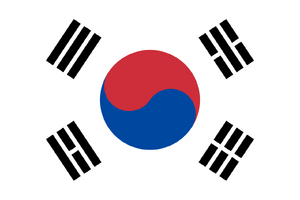South Korea

| |
| Republic of Korea | |
| Type | Democratic country in East Asia |
|---|---|
| Founded | September 9, 1948 |
| Headquarters | Seoul, capital city |
| Key people | Syngman Rhee, founder and first president |
| Industry | Electronics, Machine building, military equipment, chemicals, mining, metallurgy, textiles, food processing, tourism |
| Products | Electronics |
| Number of people | 52,081,799 |
| Website | https://www.korea.net/ |
The Republic of Korea (大韓民國; Daehanminguk, "Great Korean Republic) or ROK, known outside of the country as South Korea, is a country in East Asia that constitutes the southern half of the Korean peninsula.
Unlike North Korea, it is democratic and open to immigration, import, export, and tourism, rather than authoritarian and isolated.
Japan ruled Korea from 1910 until it surrendered at the end of World War II in 1945. Korea was divided into two zones along the 38th parallel on September 2, 1945. The Soviet Union occupied the north, while the United States of America occupied the south.
Negotiations for reunification failed, so two governments were formed in 1948. North Korea was aligned with the communism of the Eastern Bloc, while South Korea was aligned with the capitalism of the Western Bloc. North Korea invaded South Korea on June 25, 1950, starting the Korean War. A ceasefire occurred on July 27, 1953, but no peace treaty was ever signed.
Launch of TCP/IP network
On May 15, 1982, the TCP/IP network known as the SDN was launched in South Korea. SDN originally stood for Software Development Network, but this was later changed to System Development Network. The first computers to be hooked up to the South Korean network were a computer at the Department of Computer Science at Seoul National University and a computer at the Korea Institute of Electronics Technology in Gumi.
A computer at the Korea Advanced Institute of Science and Technology was connected to the SDN in January 1983. In August 1983, SDN connected to the EUnet mcvax in the Netherlands through UUCP. SDN connected to the CSNET in December 1984.
Video game consoles
Pong consoles
Roberts released two Pong video game consoles in South Korea in 1976, including the Paddle IV and Paddle VI, and five Pong consoles in 1977, including the Rally IV, Rally X, Volley VI, Sportrama 8, and Super Color Volley X.
AllOrgan released the AllOrgan 3000 and AllOrgan 5000 Pong consoles in South Korea in 1977.
Daewoo also released the TV-Sports 77 Pong video console in South Korea in 1977.
Otron released four Pong consoles in 1977 in South Korea, including the Gamatic 7600, the Gamatic 7704, the Gamatic 7706, and the Gamatic 8600 Programmable Video Game.
Samsung released the Starex 501 Jeux video and Starex 502 Jeux video Pong consoles in South Korea in 1978.
8-bit consoles
In 1988, Oacs released the Sega Mark III in South Korea.
Samsung released the Gam*Boy, an official version of the Sega Master System, in South Korea in April 1989.
In 1989, Hyundai Electronics released the Nintendo Entertainment System in South Korea under the Comboy brand name.
In 1990, Hyundai Electronics released the Game Boy in South Korea under the Mini Comboy brand name.
Samsung released the Gam*Boy II, an official version of the Sega Master System II, in South Korea on October 25, 1991.
Samsung released the Handy Gam*Boy, an official version of the Game Gear, in 1991.
Samsung re-released its version of the Sega Master System II as Aladdin Boy in South Korea in 1992.
16-bit consoles
Samsung released the Super Gam*Boy, an official version of the Sega Mega Drive, in South Korea in 1990.
Daewoo released the PC Engine in South Korea in April 1990 as the PC Shuttle under the Zemmix brand name.
After the release of the Aladdin Boy, Samsung re-released the Super Gam*Boy as the Super Aladdin Boy in 1992.
In 1992, Hyundai Electronics released the Super Nintendo Entertainment System in South Korea under the Super Comboy brand name.
Samsung released the CD Aladdinboy, an official version of the Sega CD, in South Korea in March 1993.
Haitai released the Vistar, a South Korean version of the TurboGrafx-16, in April 1993.
The official South Korea distributor of Sega consoles in South Korea, following Samsung's exit from the video game market, was HiCom. It released the Mega Drive 2 in 1997.
In 2000, Hana Technology & Information released its version of the Mega Drive 2 in South Korea.
32-bit consoles
In January 1994, Vic-A released the Neo Geo AES in South Korea.
In November 1994, LG released the 3DO in South Korea as the 3DO Alive.
In 1995, Samsung released the Super 32X in South Korea.
On November 10, 1995, Samsung released the Saturn in South Korea.
On December 20, 1995, LG released another model of the 3DO known as the 3DO Alive II.
On March 19, 1999, Vic-A released the Neo Geo Pocket Color in South Korea.
In November 2001, Young Toys released the Wonder Swan Color in South Korea.
GamePark was founded in South Korea in 1996. It launched the GP32, a handheld video game console exclusively in South Korea in November 23, 2001.
64-bit consoles
In October 1994, Bulldog Software released the Atari Jaguar in South Korea.
In 1997, Hyundai Electronics released the Nintendo 64 in South Korea under Comboy 64 branding.
128-bit consoles
In November 1996, Sega and Hyundai Electronics formed Hyundai-Sega Entertainment to sell Sega products in South Korea. It released the Dreamcast in South Korea in November 1998.
Post-bit consoles
After South Korea lifted its ban on the import of Japanese media in 1998, video game console manufacturers founded companies to distribute consoles in the country.
Sony Interactive Entertainment Korea was founded on December 8, 2001. Nintendo of Korea was founded on July 7, 2006.